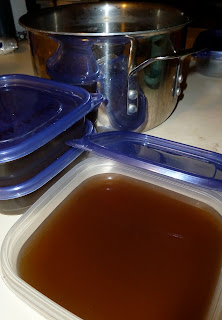I've shown you a picture of my freezer before. It's chock full of stock. (Although in that photo most of the stock is hiding out in the back.) I mainly keep vegetable stock on hand, since I mainly eat vegetables, but there are usually few quarts of chicken stock lurking in there too. Stocks get used on a weekly basis in our kitchen. They're not just for soups. You can boil grains in them (some of my favorites - brown rice, quinoa, bulgar). You can use them for sauces. When I was sick with the plague last month, I sipped on hot nutrient-dense chicken broth because that's all my throat would allow. (Do you know the difference between stock and broth? No? Check it out here.) To save money and avoid all the sodium and potential msg hidden in canned and boxed stock, I make my own. It's craaaaazy easy.
I'm sure there are many "correct" ways to make vegetable stock, but I use a loose recipe and then throw in whatever else I may have on hand. I always make sure a few carrots, some celery, onion, and garlic find their way into the pot. This time I had some past-their-prime mushrooms, potatoes, and parsley too.
Gather your ingredients and chop them up. Don't work too hard. Big, uneven chunks are okay. You don't even have to peel the onion. Just chop it into 4-6 big chunks and throw it in.
Use a big pot because you'll have a lot of vegetables. Cover them with water, throw in a bay leaf, and start them to boiling. Let them simmer for a few hours. There's no magic formula that I've found. Just take a sip every now and then to see if it has enough flavor for your liking. Remember it doesn't need to be able to stand alone with it's flavor. It's usually plays more of a supporting role. Just make sure it's not too weak.
When you're done the stock should have a deep color. This one is brown because of all the mushrooms I threw in. Usually they tend to be a deep yellow. Put a strainer or colander over a large bowl and pour the stock through, separating all the solids. Once you've pour out all the liquid, use the back of a wooden spoon to mash the veggies in the strainer and squeeze out as much liquid as possible. Throw out the veggies and ladle your stock into freezer containers.
Honestly, it only takes 30 minutes or less of hands-on time. Other than that you just need to be around for a few hours while it simmers. This batch made about 15 cups of stock (which is the equivalent of about 10 cans that I would previously buy). It would have cost me at least $10-15 in the store but the veggies I used to make it myself added up to only a few dollars. Not only are we avoiding sodium, msg, and preservatives, but at the rate we use stock we're cutting over $20 a month out of our grocery bill. That's over $200 a year. Not too shabby.
Vegetable Stock
I find the first four ingredients the most important. I throw the others in if I have them on hand. If you're a carnivore, most general cookbooks should be able to give you instructions for a chicken or beef stock. Other than veggie, chicken stock is what I make the most of. If you can't find a recipe, it's simple. Trust me. Use the bones of any chicken you've had recently. Cover with water and simmer for several hours. Skim foam off the top if it forms. Strain the solids out the same as you would for the veggie broth, let cool, and freeze.
1 large onion
3-4 cloves of garlic
2-3 carrots
2 celery stalks
5-10 mushrooms, rinsed
2-3 small potatoes
1-2 sprigs of parsley
1 baby leaf
Roughly chop the ingredients and combine in a large pot. Add about 16 cups of water. Bring to a boil and then simmer for several hours. When the flavor has developed and the color has deepened, remove from heat. Pour liquid into a large pot or bowl through a strainer, to remove the solids. Squeeze the solids with the back of a wooden spoon so that any remaining liquid will drip through the strainer. Discard the solids. Let the stock cool slightly, then ladle into freezer containers.


No comments:
Post a Comment